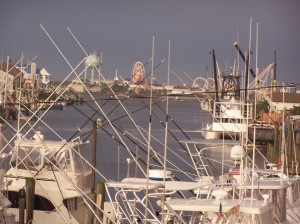
OCEAN CITY — Local watermen next week will make a pitch to county officials seeking a long-term solution to a growing problem with the silting in of the channel at the entrance to the commercial harbor that is threatening the viability of Maryland’s only Atlantic port.
The channel leading into the commercial harbor is routinely dredged to a depth of 10 feet two times a year to allow larger vessels to exit and enter the port to unload their catches of various species vital to the economic health of the harbor. Unfortunately, however, the channel at the mouth of the harbor silts in to a depth unaccommodating to many of the larger vessels that access the port.
John Martin of the Martin Fish Company said this week the problem is increasing in frequency, forcing many of the commercial fishing vessels that access the harbor to enter only on the highest of tides, or in some cases, avoid the West Ocean City harbor altogether. Martin is planning to make an appeal to the Worcester County Commissioners next week to work with their state and federal partners for a more frequent dredging schedule.
“I’m hoping to get Worcester County, the state, the federal government and anyone else who benefits from this commercial harbor to recognize the problem and come up with a solution to remedy it,” he said. “It’s dredged in the spring and fall, but it needs to be dredged more frequently to prevent this from becoming a larger issue.”
Martin said just this week, a large commercial vessel ran aground near the entrance to the harbor and the Ocean City Inlet, forcing the captain and crew to wait outside the harbor for about three hours until the tide changed in order to get in an unload its catch. He said it’s a problem that’s happening with more and more frequency.
“Three hours is a long time and time is money,” he said. “For some of the boats that have a little Maryland quota for different species already, the problem has increased to the point they are seeking alternative ports to offload their catches.
“Some of the larger boats, the 70 and 75 footers, are running in there and scraping bottom or getting stuck, even on a medium and sometimes high tide,” he said. “Unless we can come up with a better solution or a more frequent dredging schedule, they’re going to start going elsewhere. It will keep a lot of money and commerce from coming across those decks at the West Ocean City harbor.”
Martin said the trouble spot is between red buoy 12 and green buoy 11 across from Martha’s Landing. He said the problem has been a persistent one, but has grown more acute in recent weeks. While the largest impact is on the commercial vessels utilizing the harbor, it has grown to the point it is also affecting some of the larger recreational fishing vessels in and out of the area.
“It really starts around those two buoys,” he said. “It starts out deep enough, but the bottom runs up hill as you approach those buoys. In some case, you have to almost hit the red buoy to get through, and in other cases, the boats are leaving the channel altogether to find water deep enough to enter the harbor.”
He said the silting in at the mouth of the harbor is likely being caused by a variety of natural and man-made factors. With the other channels dredged routinely and the dredged material deposited on the various islands and beaches in the area, the sand is washing away and ending up in the channel near the harbor.
Martin said the swirling waters during the tide changes near the harbor are likely the culprit, but said there is no firm science to back up that speculation. He plans to present the issues to the commissioners on Tuesday in the hopes of identifying the cause and working with state and federal partners on a long-term solution.
